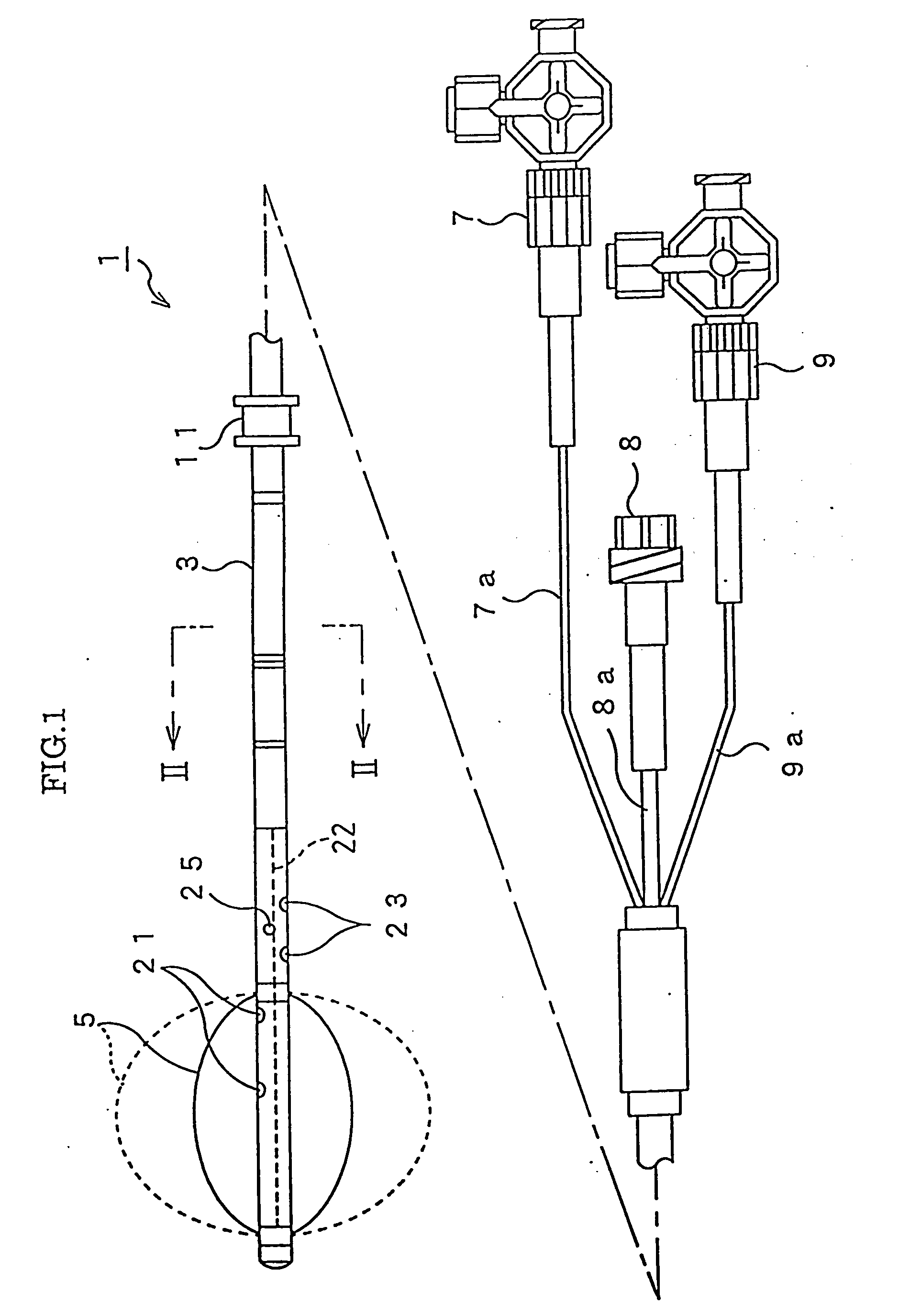Occlusion catheter for the ascending aorta
a technology for occlusion catheters and ascending aortas, which is applied in the field of occlusion catheters for ascending aortas, can solve the problems of occlusion catheters, hindering the blood flow to the lower limb, and obstructing blood flow
- Summary
- Abstract
- Description
- Claims
- Application Information
AI Technical Summary
Benefits of technology
Problems solved by technology
Method used
Image
Examples
first embodiment
[0050] First Embodiment
[0051] As shown in FIG. 1, an occlusion catheter for the ascending aorta 1 according to the present invention is provided with a catheter tube 3, a balloon 5, a first connector 7, a second connector 8, a third connector 9 and a tie cushion 11, etc.
[0052] The catheter tube 3 made of polyurethane is long enough to include a portion with a length of 400 mm and an outer diameter of 3.6 mm which is insertable into a blood vessel. As shown in FIG. 2, a first lumen 15, a second lumen 17 and a third lumen 19 are formed separately from one another within the catheter tube 3.
[0053] The first lumen 15 has one end communicating with the first connector 7 through a first auxiliary tube 7a and the other end communicating with a plurality of inflation agent supply and drainage apertures 21 having a diameter of 1 mm and formed inside the balloon 5. The first lumen 15 is used as a path for guiding an inflation agent (e.g. a physiological salt solution) supplied from the first ...
second embodiment
[0067] Second Embodiment
[0068] As shown in FIG. 6, an occlusion catheter 101 according to a second embodiment of the present invention is provided with a catheter tube 103, a balloon 105, a first connector 7, a second connector 8, a third connector 9 and a tie cushion 111, etc.
[0069] The catheter tube 103 made of polyurethane is long, and a first lumen 115 and a second lumen 117 are formed therein separately from each other as shown in FIG. 7A.
[0070] The first lumen 115 has one end communicating with the first connector 7 through a first auxiliary tube 7a (see FIG. 6) and the other end communicating with a plurality of inflation agent supply and drainage apertures 121 formed inside the balloon 105. The first lumen 115 is used as a passage for guiding an inflation agent (e.g. a physiological salt solution) supplied from the first connector 7 side to the inside of the balloon 105.
[0071] The second lumen 117 has one end communicating with the second connector 8 through a second auxilia...
third embodiment
[0093] Third Embodiment
[0094] In a third embodiment, a side aperture 325 for releasing the drug therefrom is provided in a catheter tube 303 in the position corresponding to the approximate center of a balloon 305, as shown in FIGS. 12A and 12B. The balloon 305 has concavities 331 and 332 on the outer surface when inflated in the same manner as in the second embodiment, and also has a depression in a part of the center portion of the balloon 305. The balloon 305 is joined to the catheter tube 303 within the depression and the concavities. At the bottom of the depression is provided the side aperture 325 for communicating the second lumen 317 with the outside of the catheter tube 303 (see FIG. 13). Since the other elements are similar to the elements in the first embodiment, particular description is omitted.
[0095] An occlusion catheter according to the present embodiment, as schematically illustrated in FIG. 13, is inserted into the ascending aorta as in the first and the second emb...
PUM
 Login to View More
Login to View More Abstract
Description
Claims
Application Information
 Login to View More
Login to View More - R&D
- Intellectual Property
- Life Sciences
- Materials
- Tech Scout
- Unparalleled Data Quality
- Higher Quality Content
- 60% Fewer Hallucinations
Browse by: Latest US Patents, China's latest patents, Technical Efficacy Thesaurus, Application Domain, Technology Topic, Popular Technical Reports.
© 2025 PatSnap. All rights reserved.Legal|Privacy policy|Modern Slavery Act Transparency Statement|Sitemap|About US| Contact US: help@patsnap.com



